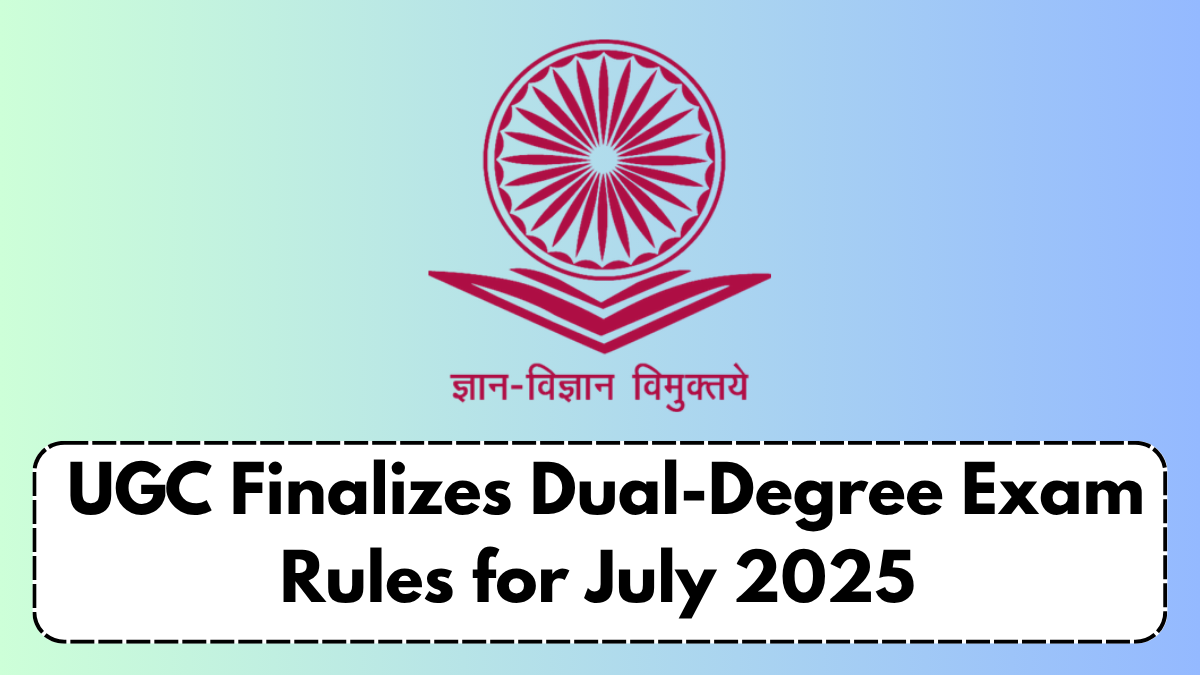The University Grants Commission (UGC) has officially announced the UGC dual degree exam rule 2025, marking a significant shift in higher education under the NEP 2020 framework. Starting July 2025, students across India can pursue two academic programs simultaneously, provided they adhere to the newly released simultaneous course guidelines. This move aims to promote interdisciplinary learning and enhance career flexibility.
Under the updated policy, students can enroll in a combination of degrees—such as two undergraduate programs, two postgraduate programs, or one of each—as long as the class schedules do not overlap. The UGC emphasizes that institutions must ensure transparency in timetabling to prevent conflicts. Additionally, online and distance learning programs have been given equal weightage, enabling students to balance physical and virtual coursework seamlessly.

Key Guidelines for Enrolling in Simultaneous Courses
The UGC dual degree exam rule 2025 outlines specific conditions for students opting for dual degrees. Below are the critical guidelines:
-
Eligibility Criteria: Students must maintain a minimum attendance of 75% in both programs.
-
Exam Scheduling: Universities must avoid overlapping examination dates for dual-degree candidates.
-
Credit Transfer: A maximum of 40% credits can be shared between the two programs if the curricula align.
-
Discipline Restrictions: Science and engineering students can combine degrees with humanities or management, but two technical degrees (e.g., BTech + MBBS) remain prohibited due to practical constraints.
To simplify compliance, here’s a breakdown of permissible degree combinations:
| Primary Degree | Allowed Simultaneous Degree |
|---|---|
| BA (Humanities) | BCom/BBA |
| BSc (Science) | MA (Economics) |
| MBA (Management) | PG Diploma in Data Science |
How NEP 2020 Influences the Dual-Degree Framework
The NEP 2020 has been instrumental in reshaping India’s education system, and the UGC dual degree exam rule 2025 is a direct outcome of its multidisciplinary approach. By allowing simultaneous course guidelines, the policy encourages students to diversify their skill sets, making them more adaptable to global job markets.
For instance, a student pursuing a Bachelor’s in Psychology can now enroll in a parallel program in Digital Marketing, blending behavioral science with technical expertise. Universities are also mandated to establish academic counseling cells to guide students in selecting complementary courses that align with their career goals.
Challenges and Opportunities for Institutions
While the new rules offer flexibility, they also pose logistical challenges for universities. Institutions must upgrade their infrastructure to handle dual enrollments, including digital platforms for attendance tracking and exam management. Faculty training programs will be essential to address the nuances of teaching students with varied academic loads.
On the brighter side, this system opens revenue streams for colleges through increased enrollments. It also fosters collaborations between departments, paving the way for innovative integrated courses. For example, a university might develop a hybrid program combining Environmental Science and Public Policy, catering to students interested in sustainability governance.
Preparing for the July 2025 Rollout
With the UGC dual degree exam rule 2025 taking effect in July 2025, students and institutions must prepare in advance. Prospective applicants should review university websites for approved degree combinations and admission timelines. Meanwhile, colleges are expected to publish detailed syllabi and class schedules by March 2025 to help students make informed choices.
Scholarships and financial aid for dual-degree seekers are also under discussion, with the UGC urging state governments to introduce fee waivers for economically disadvantaged students. This initiative could democratize access to multidisciplinary education, a core objective of NEP 2020.
Conclusion
The UGC dual degree exam rule 2025 is a transformative step toward modernizing India’s education landscape. By embracing simultaneous course guidelines, students gain the freedom to explore diverse fields without compromising depth or quality. As July 2025 approaches, stakeholders must collaborate to ensure smooth implementation, unlocking new academic and professional possibilities for future generations.
FAQ
What is the UGC dual degree exam rule 2025?
The UGC has approved a policy allowing students to pursue two academic degrees simultaneously from July 2025, provided the programs meet scheduling and disciplinary criteria.
Can I pursue two technical degrees under the new guidelines?
No, the simultaneous course guidelines prohibit enrolling in two technical programs (e.g., BTech + MBBS) due to practical and workload constraints.
How will attendance be managed for dual-degree students?
Students must maintain a minimum of 75% attendance in both programs. Universities will use digital systems to track attendance across courses.
Will online degrees be considered under this policy?
Yes, the UGC permits combining online, distance, and offline programs, provided the institution is recognized.
Are there credit-sharing options between dual degrees?
Up to 40% of credits can be transferred if the syllabi of the two programs overlap, subject to university approval.
Click here to learn more
Akesh is a talented content writer known for creating captivating and impactful narratives. He understands what resonates with audiences and tailors his content to inform, inspire, and engage. From blog posts and articles to marketing copy, his work consistently combines creativity with clarity. His skillful writing strengthens our brand’s voice and ensures our message leaves a meaningful impression.



